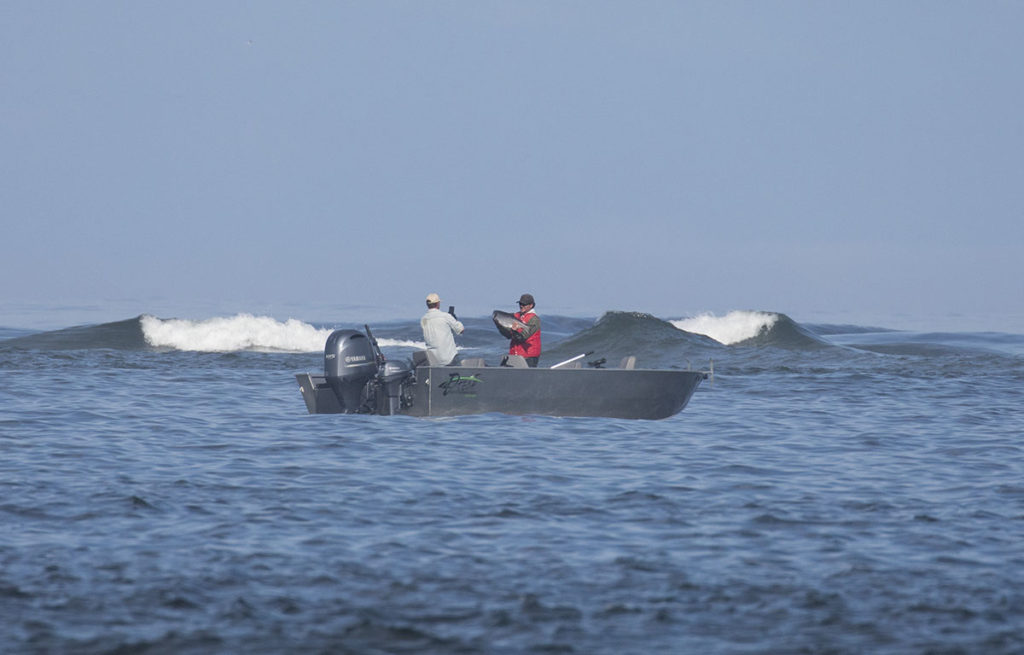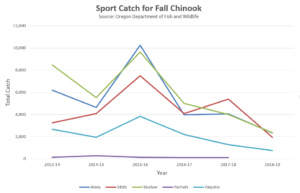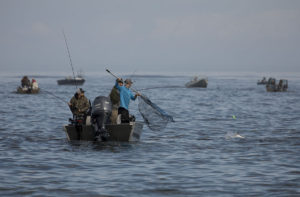
By QUINTON SMITH/YachatsNews.com
An improved forecast for returns of fall Chinook to central coast streams means that daily and season bag limits are increasing for the first time in two years.
Poor forecasts by the Oregon Department Fish and Wildlife in 2019 and 2020 meant limits on most coastal streams were one wild, fall Chinook a day and five for the season.
But expectations that the fall run is improving resulted in the state’s fishery managers returning to Chinook limits of two fish a day and 20 salmon this season – limits that were the norm from 2010 to 2019.

“Overall, it’s going to be a better year than the last two years,” said John Spangler, the Newport-based ODFW biologist for the mid-Oregon coast. “It (Chinook fishing) should be improved this year.”
Chinook limits are also increased on the Yachats River, but are still much below the larger streams like the Alsea and Siletz.
In 2020 the limit for the Yachats River was one Chinook for the year; in 2019 it was two for the year. This year the limit is one per day and five for the year.
If there is one worry this fall, it is the severe Oregon drought that has also hit the coast this spring and summer. While it should not affect early fishing for fall Chinook in coastal bays and lower estuaries, there could be issues in September and October when salmon make a push for upriver spawning grounds, Spangler said.
“We’ll be keeping an eye on that through the fall, and if conditions warrant we’ll move on some temporary regulations,” Spangler said.
In past years that meant prohibiting salmon fishing in upper tidewater areas of coastal streams where the water is particularly low and warm.
Ocean conditions improving for salmon
The abundance issue has a lot to do with ocean conditions conducive to providing lots of forage for Chinook salmon, which spend 1-5 years at sea. Conditions were poor 3-4 years ago when salmon migrated out from coastal rivers but have been slowly improving, Spangler said.
Ocean conditions last year were “very good” for salmon and are good again this year, he said. Salmon, which feed in the top layers of water, are not as affected by low-oxygen levels – called hypoxia
— now being reported in some parts of the ocean off the West Coast that impact marine life near the ocean floor.
Nearly all the fall Chinook returning to the central Oregon coast are “wild” fish, meaning they are not raised in state or federal hatcheries and have much lower limits on the number that can be caught. The only fall Chinook hatchery program on the central coast is in the Salmon River north of Lincoln City.
Fishermen sometimes link ocean fishing for Chinook with how runs will be in coastal streams. But the Chinook runs into coastal streams are different. Chinook being caught now in the ocean are headed north to the Columbia River or south to the Klamath and Sacramento rivers. Chinook headed up coastal rivers originate in water off Alaska and Canada.

More fall Chinook in Oregon are also being helped by commercial fishermen in British Columbia and Washington last year and this year taking just half of their salmon quota, Spangler said, leaving more fish for coastal Oregon.
Fishing off the Oregon coast is currently very good for coho salmon, but most of those fish are headed to the mouth of the Columbia River, Spangler said.
Some 125,000 wild coho salmon are expected to hit coastal streams south of the Columbia, Spangler said. Except for a tiny one-fish limit in the Siletz River, keeping of any mid-coast wild coho salmon, which is listed as threatened under the federal Endangered Species Act, is prohibited.
There are no large coho hatchery programs on the central coast. Fishermen will occasionally catch some adipose-clipped coho – they are legal to keep – but they are coho headed to north coast rivers straying into local rivers chasing bait.
“They’re doing pretty good,” Spangler said of the wild coastal coho stocks. “…but they are very difficult to forecast; they’re a boom and bust fish.”
The outlook for winter steelhead is not so good, Spangler said.
Ocean conditions when steelhead smolts migrated to the ocean during the spring two years ago were not good, resulting in low survival rate.
“For this next year I wouldn’t expect good returns … but they can always surprise you” Spangler said.
Stream by stream
Because of improved forecasts for fall Chinook, bag limits have increased on most central Oregon coast streams. Here is a stream-by-stream breakdown of bag limits Aug. 1 through Dec. 31:
- Alsea River, including Drift Creek: Two wild Chinook salmon per day and 20 for the period. Five jack salmon per day.
- Siletz River, Siletz Bay, Drift and Schooner creeks: Two wild Chinook salmon per day and 20 for the period. Five jack salmon per day.
- Yaquina River including Big Elk Creek: Two wild Chinook salmon per day and 20 for the period. Five jack salmon per day.
- Yachats River: One adult, wild Chinook salmon for the day and five for the period. Five jack salmon per day.
- Siuslaw River, including the North Fork Siuslaw: Two wild Chinook salmon per day, 20 for the period.
- Coquille River basin: Closed.
- Big Creek & Tenmile Creek: Closed.



